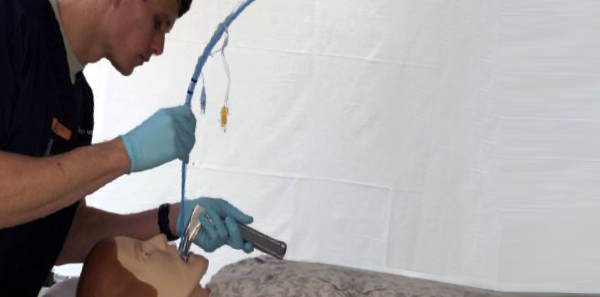
Ever since the BEAM (Bougie Use in Emergency Airway Management) trial was published in JAMA in 2018, the use of the bougie has become increasingly mainstream.1 Some of the advantages of using a bougie are known, but there are also misconceptions about its use, how to maximize success with it, and why we should be using it for most, if not all, airways. We’ll summarize that here.
Explore This Issue
ACEP Now: Vol 40 – No 02 – February 2021Background
The use of the gum elastic bougie was first described in a 1949 letter by Dr. R.R. Macintosh (of whose eponymous laryngoscope blade we are all familiar).2 In that letter, Dr. Macintosh wrote about using what was essentially a urinary catheter. The term “gum elastic bougie” is actually somewhat of a misnomer; the most common form of the bougie as we know it was introduced in 1973 as the Eschmann tracheal tube introducer, and it is not made of gum, not elastic, and not a bougie (at least with respect to the original medical definition, that being a cylindrical instrument meant for introduction into the urethra or other tubular structures in order to dilate constrictures).3 Nevertheless, the name has stuck.
Why Use a Bougie?
First and foremost, the bougie leads to increased first-pass success in obtaining a definitive endotracheal airway. In the BEAM trial, the bougie had a 98 percent first-pass success rate versus 87 percent in the stylet group. What’s more, in patients with at least one difficult airway characteristic, the bougie group had a successful first attempt in 96 percent of patients compared to 82 percent in the stylet group.
This increased success rate is likely attributable to two factors. The first is the enhanced ability to obtain visual confirmation of tracheal placement compared to direct endotracheal tube (ETT) placement without the bougie. Given its 15 French (5 mm) diameter, it is much easier to visualize passage of the bougie through the vocal folds compared to an ETT and stylet setup. In fact, Dr. Macintosh himself noted this as its principal advantage in his original correspondence.
The second factor has to do with tactile confirmation. This is confirmed in one of two ways by the operator. One can use the angled coudé tip of the bougie to rock it along the tracheal rings, eliciting a “clicking” sensation. One can also (gently) advance the bougie until resistance is felt either at the carina or in either of the mainstem bronchi; this is known as the “hold-up” sign. In one study, tracheal clicks were felt in 89.7 percent of intubations and had a 100 percent specificity of successful ETT placement.4 In the same study, the hold-up sign was 100 percent sensitive and specific for successful placement. What’s more, an observer (such as a supervising physician attending on a resident procedure) can place their hand externally on the trachea and independently confirm placement when tracheal clicks are felt.
Trauma airway management offers another situation in which the bougie can come in handy. Manual in-line stabilization (MILS) is known to decrease the grade of view of the glottis. One study showed a prevalence of 22 percent of grade III views in patients with MILS.5 That study showed increased intubation success when the bougie was used, and all patients who were unable to be intubated under direct visualization were rescued with the addition of a bougie.
However, there is one method that can help maximize success in the most difficult of airway scenarios (ie, Cormack-Lehane [CL] views III and IV). Interestingly, this technique appeared in the original paper describing the CL grading system way back in 1984.6 It involves first obtaining an adequate view of the cords, then retracting the laryngoscope slightly to allow the epiglottis to drop down, thereby converting the view from a CL grade I to a grade III. You can then use the coudé tip of the bougie to trace the posterior of the surface of the epiglottis through and past the vocal cords. While probably not the best strategy for emergent airway management, this technique can be practiced in any cadaver or in the simulation lab. Arguably, the biggest advantage of a bougie is the ability to pass it blindly into the trachea when adequate visualization is not possible, so mastering this technique can strengthen your repertoire for salvaging the most challenging of airways.
Moreover, a bougie can also assist with blind digital intubation when necessary.7 Also, in the case of moderate and massive hemoptysis, rotating the coudé tip 90 degrees to the right or left after insertion past the cords facilitates selective lung intubation. One cadaver study showed this technique to be successful 100 percent of the time.8
In addition to increased first-pass success, the bougie has other useful applications. The “scalpel-bougie-tube” technique has become the preferred method for many operators during the emergency establishment of a surgical airway, and among other places, it is taught in the United Kingdom’s Difficult Airway Society training.9
Pages: 1 2 3 4 | Single Page





2 Responses to “The Bougie as an Airway Savior”
March 9, 2021
Robert ProsserAMEN. I’be been practicing EM for 45 years, residency trained, etc, trauma centers, etc. Especially in this covid where rapid intubation is important to limit contamination, it can be slipped in much quicker than the tube and reduces failures. In C-L IV, you can slip the bougie under the epiglottis without seeing the cords and feel the clicking to know the location is correct. I ALWAYS have one open when I intubate, and usually use one. Every time I have had to help someone with a failed airway, this has saved us.
March 14, 2021
George KovacsThanks for your nice review. Your readers may be interested in recently released deep dive into bougie use we posted to support our AIME programming (A Canadian, National airway program) that has been supporting airway learners and practitioners for over 20 years. It’s all FOAM materials:
1. Laryngoscopy and Bougie Pearls and Pitfalls Part 1: When and Why:
https://www.youtube.com/watch?v=hjF0KgQVLvA&ab_channel=AIMEAirway
2. Laryngoscopy and Bougie Pearls and Pitfalls Part 2: How to
https://www.youtube.com/watch?v=CfU_ZdJ9hzA&ab_channel=AIMEAirway
Note website is being modified